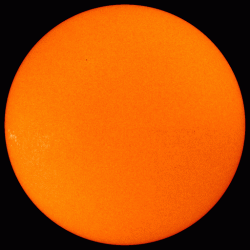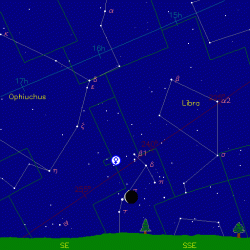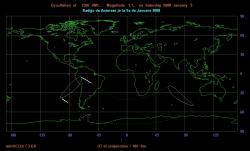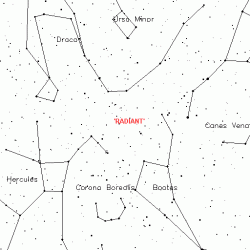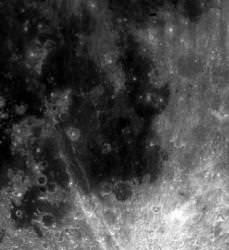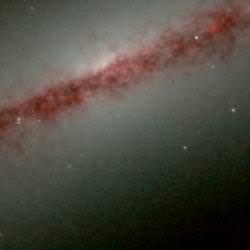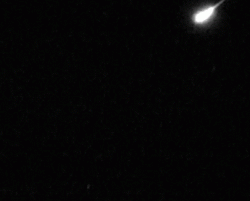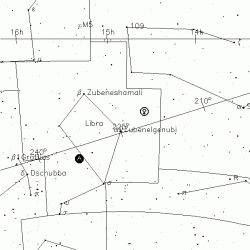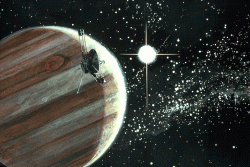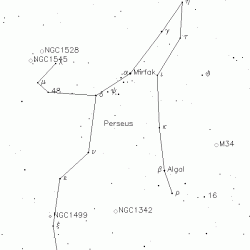Please note that this is going to be the last edition of the What’s Up series of articles on Universe Today. From here on out, Tammy’s daily skywatching guide will be published in a book called the Night Sky Companion. Tammy is still writing for Universe Today, and will be posting articles about skywatching and events on a regular basis.
Monday, December 24 – Twas the night before Christmas in a sky filled with stars… And low on the horizon are the Yule Moon and Mars! That’s right. It’s the Full Yule Moon, and arriving at the same time Mars reaches opposition. For many viewers, the spectacular pair will rise with Mars less than a degree south of Luna… But a pairing this close means a few lucky observers could be in for an occultation event! Be sure to check IOTA for possible times and locations.
Today in 1968, Apollo 8 became the first manned spacecraft to orbit the Moon. Let’s celebrate that by having a look at the lunar surface. On the eastern limb we see the bright splash ray patterns surrounding ancient Furnerius – yet the rays themselves emanate from much younger crater Furnerius A. All over the surface, we see small points light up and the testament to the Moon’s violent past written in its scarred lines. Take a look now at the western limb… For the sunrise is about to advance around it.
Until this date, no man had seen with his own eyes what lay beyond. Frank Borman, James Lovell and William Anders were to become the first to directly view the “dark side” and the first to witness earthrise over the Moon. As the days ahead bring the terminator around to the eastern limb, let your mind take flight to the distant orb and enjoy its landscape as the shadows take on new angles and old features become new again.
“And from the crew of Apollo 8, we close, with good night, good luck, a Merry Christmas, and God bless all of you, all of you on the good Earth.” (Astronaut Frank Borman)
Tuesday, December 25 – Wishing you all the very best for the Christmas season! Like a present, Sir Isaac Newton was born on this day 1642 – Newton was the British “inventor” of calculus and a huge amount of what we now consider modern classical physics. Even young children are aware of his simple laws of motion and gravity. It wasn’t until the time of Einstein until things changed!
In keeping with the season, tonight’s astronomical object is a celebration of both starlight and asterism. Located 10 degrees east of Betelgeuse (RA 06 41 00.00 Dec +09 53 -0.0), NGC 2264 will be a challenging object thanks to the Moon. Also known as the “Christmas Tree Cluster,” this bright asterism of approximately 20 bright stars and over 100 fainter ones is embroiled in a faint nebula that will be lost to bright skies, leaving only the delightful Christmas tree shape adorned with stars.
The very brightest of these stars, S Monocerotis, is 5th magnitude and will show clearly in the finderscope, and will be seen as a double at magnification. Steady skies will reveal that the “star” at the top of our “tree” is also a visual double. Many of the stars will also appear to have companions, as well as tints of silver as gold. The visual effect of this splendid open cluster is well worth the challenge it presents. Happy Holidays!
Wednesday, December 26 – Is it gone yet? Nope. The Moon will rise a little later this evening, but we’re going to run ahead of it tonight and enjoy some studies in Auriga! Looking roughly like a pentagon in shape, start by identifying the brightest of these stars – Capella. Due south of it is the second brightest star, El Nath. By aiming binoculars at El Nath, go north about one-third the distance between the two and enjoy all the stars!
You will note two very conspicuous clusters of stars in this area, and so did Le Gentil in 1749. Binoculars will reveal the pair in the same field, as will telescopes using lowest power. The dimmest of these is M38, and it will appear vaguely cruciform in shape. At roughly 4200 light-years away, larger aperture will be needed to resolve the 100 or so fainter members. About two and a half degrees to the southeast you will see the much brighter M36. More easily resolved in binoculars and small scopes, this “jewel box” galactic cluster is quite young – and about 100 light-years closer!
Thursday, December 27 – Born today in 1571 was Johannes Kepler – Danish astronomer and assistant to Tycho Brahe. Kepler used Brahe’s copious notes of Mars’ positions to help formulate his three laws of planetary motion. These laws are still in use today.
Is it gone yet? No. The Moon will be along shortly, but we still have time to set our sights about halfway between Theta Aurigae and El Nath. Our study object will be the open cluster M37. Apparently discovered by Messier himself in 1764, this galactic cluster will appear almost nebula-like to binoculars and very small telescopes – but comes to perfect resolution with larger instruments.
At around 4700 light-years away, and spanning a massive 25 light-years, M37 is often billed as the finest of the three Aurigan opens for bigger scopes. Offering beautiful resolvability, this one contains around 150 members down to magnitude 12, and has a total population in excess of 500.
What makes it unique? As you view, you will note the presence of several red giants. For the most part, open clusters are comprised of stars that are all about the same age, but the brightest star in M37 appears orange in color and not blue! So what exactly is going on in here? Apparently some of these big, bright stars have evolved much faster – consuming their fuel at an incredible rate. Other stars in this cluster are still quite young on a cosmic scale, yet they all left the “nursery” at the same time! In theory, this allows us to judge the relative age of open clusters. For example, M36 is around 30 million years old and M38 about 40, but the presence of the red giants in M37 puts its estimated age at 150 million years! Just awesome…
Friday, December 28 – Today we celebrate the birth of Arthur S. Eddington. Born in 1882, Eddington was a British theoretical astrophysicist whose work was fundamental to interpreting and explaining stellar nature. He also coined the phrase “expanding universe” to refer to the mutual recession of the galaxies.
Is it gone yet? Not yet… But before the Moon rises tonight, let’s enjoy the early dark skies and go to our maps west of M36 and M38 to identify AE Aurigae. As an unusual variable, AE is normally around 6th magnitude and resides approximately 1600 light-years distant. The beauty in this region is not particularly the star itself but the faint nebula in which it resides. Known as IC 405, this is an area of mostly dust and very little gas. What makes this view so entertaining is that we are looking at a “runaway” star.
It is believed that AE originated in the M42 region in Orion. Cruising along at a very respectable speed of 130 kilometers per second, AE flew the “stellar nest” some 2.7 million years ago! Although IC 405 is not directly related to AE, there is evidence within the nebula that areas have been cleared of their dust by the rapid northward motion of the star. AE’s hot, blue illumination and high energy photons fuel what little gas is contained within the region, and its light reflects off the surrounding dust as well. Although we cannot “see” with our eyes like a photograph, together this pair makes an outstanding view for the small backyard telescope, and it is known as “The Flaming Star.”
And when the Moon rises? Look for Regulus less than one half degree to its north and Saturn another two degrees further. This could be an occultation of Regulus, so be sure to check IOTA!
Saturday, December 29 – If you’re up before dawn this morning, take the time to step outside and view the simple beauty of the ecliptic plane. To the west, Mars hangs just above the horizon with Saturn not far above it. The Moon dances high overhead and Venus shines just before the rising Sun. In a matter of weeks, Jupiter will return again to the morning skies!
Is it gone yet? Not yet. Since the Moon won’t begin to interfere for quite a while after the skies turn dark, this would be a great opportunity to locate an easy Messier object – M34. If you remember our previous study stars Almach and Algol, you’re halfway there. Draw an imaginary line between them and look with your binoculars or finder scope just a shade north of center.
In binoculars, M34 will show around a dozen fainter stars clustered together, and perhaps a dozen more scattered around the field. Small telescopes at low power will appreciate M34 for its resolvability and the distinctive orange star in the center. Larger aperture scopes will need to stay at lowest power to appreciate the 18 light-year span of this 100 million year old cluster, but take the time to power up and study. You will find many challenging doubles inside!
Sunday, December 30 – Is it gone yet? Not quite! The Moon will be along much later, but not before we’ve had an opportunity to head for another northern gem, M76.
Located in western Perseus just slightly less than one degree north-northwest of Phi, M76 is often referred to as “The Little Dumbbell.” Originally discovered by Messier’s assistant MÈchain in September of 1780, Charles didn’t get around to cataloging it for another six weeks. What a shame it took him so long to view this fine planetary nebula! Its central star is one of the hottest known, but its resemblance to M27 is what makes it so fascinating.
Looking very much like a miniaturization of the much larger M27, M76 is rather faint at magnitude 11, but is quite achievable in scopes of 114mm in aperture or larger. It is small, but its irregular shape makes this planetary nebula a real “class act!”
For our Southern Hemisphere friends, get thee out there and view Eta Carinae! First recorded by Halley in 1677, this nebular variable star left even the great Sir John Herschel at a loss to describe its true beauty and complexities. This “slow nova” is filled with all the wonders that we “northerners” can only dream about…
Monday, December 31 – Today is the birthday of Robert G. Aitken. Born in 1864, Aitken was a prolific American observer who discovered and catalogued more than 3100 double and binary stars. Just look at what a prolific observer YOU have become in just a year!
Is it gone yet? No. The Moon will be around much later tonight, but the year 2007 is just about ended. Try celebrating in a unique and inspiring way! Go observing…
In the hours before midnight, you could take a cosmic journey that spans millions of light-years. In the northern hemisphere, visit with the Andromeda Galaxy again – or the Small and Large Magellanic Clouds if you live in the South. Feast your eyes on vast and wondrous displays of stars like the “Double Cluster” in Perseus, or the “Jewel Box” – the Kappa Crucis star cluster. Rejoice in the birth of new stars by voyaging to M42 – the Orion Nebula… And remember the old by returning to M1 – the Crab Nebula. Take delight in the movements of our own solar system by watching Mars rise, or peeking in on Saturn’s rings as it follows behind. Perhaps the ISS will make a pass over your area tonight, or maybe only a single star will shine through your cloudy sky. It may be something as spectacular as watching a meteor go down in a blaze of glory, or as quiet and contemplative as watching the Moon rise as the year ends.
Now take a moment to look up at the stars and think about all the billions of years that they have been in the making and all the time that it has taken for the light to reach us. Salute! Our observing year has been wonderful together… And I’ll look for you under the stars! I hope you’ll join me again when 2008 begins as “The Night Sky Companion.”
May all your journeys be at light speed!

